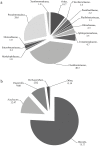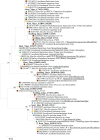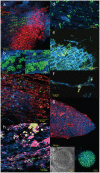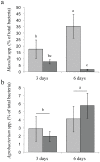Ecology of root colonizing Massilia (Oxalobacteraceae)
- PMID: 22808103
- PMCID: PMC3394795
- DOI: 10.1371/journal.pone.0040117
Ecology of root colonizing Massilia (Oxalobacteraceae)
Abstract
Background: Ecologically meaningful classification of bacterial populations is essential for understanding the structure and function of bacterial communities. As in soils, the ecological strategy of the majority of root-colonizing bacteria is mostly unknown. Among those are Massilia (Oxalobacteraceae), a major group of rhizosphere and root colonizing bacteria of many plant species.
Methodology/principal findings: The ecology of Massilia was explored in cucumber root and seed, and compared to that of Agrobacterium population, using culture-independent tools, including DNA-based pyrosequencing, fluorescence in situ hybridization and quantitative real-time PCR. Seed- and root-colonizing Massilia were primarily affiliated with other members of the genus described in soil and rhizosphere. Massilia colonized and proliferated on the seed coat, radicle, roots, and also on hyphae of phytopathogenic Pythium aphanidermatum infecting seeds. High variation in Massilia abundance was found in relation to plant developmental stage, along with sensitivity to plant growth medium modification (amendment with organic matter) and potential competitors. Massilia absolute abundance and relative abundance (dominance) were positively related, and peaked (up to 85%) at early stages of succession of the root microbiome. In comparison, variation in abundance of Agrobacterium was moderate and their dominance increased at later stages of succession.
Conclusions: In accordance with contemporary models for microbial ecology classification, copiotrophic and competition-sensitive root colonization by Massilia is suggested. These bacteria exploit, in a transient way, a window of opportunity within the succession of communities within this niche.
Conflict of interest statement
Figures





Similar articles
-
Contrasting patterns of seed and root colonization by bacteria from the genus Chryseobacterium and from the family Oxalobacteraceae.ISME J. 2007 Aug;1(4):291-9. doi: 10.1038/ismej.2007.33. Epub 2007 May 24. ISME J. 2007. PMID: 18043640
-
Colonization of cucumber seeds by bacteria during germination.Environ Microbiol. 2011 Oct;13(10):2794-807. doi: 10.1111/j.1462-2920.2011.02551.x. Epub 2011 Aug 30. Environ Microbiol. 2011. PMID: 21883798
-
Succession of bacterial communities during early plant development: transition from seed to root and effect of compost amendment.Appl Environ Microbiol. 2006 Jun;72(6):3975-83. doi: 10.1128/AEM.02771-05. Appl Environ Microbiol. 2006. PMID: 16751505 Free PMC article.
-
Soil suppressiveness to fusarium disease: shifts in root microbiome associated with reduction of pathogen root colonization.Phytopathology. 2013 Jan;103(1):23-33. doi: 10.1094/PHYTO-12-11-0349. Phytopathology. 2013. PMID: 22950737
-
Harnessing the Ecological and Genomic Adaptability of the Bacterial Genus Massilia for Environmental and Industrial Applications.Microb Biotechnol. 2025 May;18(5):e70156. doi: 10.1111/1751-7915.70156. Microb Biotechnol. 2025. PMID: 40325956 Free PMC article. Review.
Cited by
-
Effect of long-term fertilization strategies on bacterial community composition in a 35-year field experiment of Chinese Mollisols.AMB Express. 2018 Feb 13;8(1):20. doi: 10.1186/s13568-018-0549-8. AMB Express. 2018. PMID: 29442257 Free PMC article.
-
Changes in soil bacterial community structure as a result of incorporation of Brassica plants compared with continuous planting eggplant and chemical disinfection in greenhouses.PLoS One. 2017 Mar 27;12(3):e0173923. doi: 10.1371/journal.pone.0173923. eCollection 2017. PLoS One. 2017. PMID: 28346463 Free PMC article.
-
Legacy of Repeated Cultivation Drives Cyclical Microbial Community Development in a Tropical Oxisol Soil.Microb Ecol. 2025 Apr 16;88(1):30. doi: 10.1007/s00248-025-02530-3. Microb Ecol. 2025. PMID: 40240613 Free PMC article.
-
Unraveling the plant microbiome: looking back and future perspectives.Front Microbiol. 2014 Jun 4;5:148. doi: 10.3389/fmicb.2014.00148. eCollection 2014. Front Microbiol. 2014. PMID: 24926286 Free PMC article. Review.
-
Distinct microbial communities associated with health-relevant wild berries.Environ Microbiol Rep. 2024 Dec;16(6):e70048. doi: 10.1111/1758-2229.70048. Environ Microbiol Rep. 2024. PMID: 39540551 Free PMC article.
References
-
- Compant S, Clément C, Sessitsch A. Plant growth-promoting bacteria in the rhizo- and endosphere of plants: Their role, colonization mechanisms involved and prospects for utilization. Soil Biol Biochem. 2010;42:669–678.
-
- Katan Y. Waisel Y, Eshel A, Kafkafi U, editors. Interactions of soilborne pathogens with roots and aboveground plant organs. 2002. pp. 949–960. Plant Roots–the Hidden Half. New York: Marcel Dekker Inc.
-
- Raaijmakers JM, Paulitz TC, Steinberg C, Alabouvette C, Moënne-Loccoz Y. The rhizosphere: a playground and battlefield for soilborne pathogens and beneficial microorganisms. Plant Soil. 2009;321:341–361.
-
- Vance CP. Waisel Y, Eshel A, Kafkafi U, editors. Root-bacteria interactions: symbiotic N2 fixation. 2002. pp. 839–868. Plant Roots–the Hidden Half. New York: Marcel Dekker Inc.
-
- De Weert S, Bloemberg GV. Gnanamanickam SS, editor. Rhizosphere competence and the role of root colonization in biocontrol. 2006. pp. 317–333. editor. Plant-Associated Bacteria. Dordrecht: Springer.
Publication types
MeSH terms
Substances
LinkOut - more resources
Full Text Sources
Research Materials

